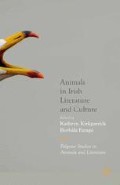Abstract
Dún na mBan trí Thine (The Women’s Fort is on Fire) has much to say about Ní Dhuibhne as an Irish female writer and, indeed, as an Irish-language writer. Marking Ní Dhuibhne’s debut as a playwright on 10 November 1994 at the Peacock Theatre in Dublin, Dún na mBan trí Thine makes extensive use of ‘The Old Woman as Hare’ legend, a tale of a woman who transforms herself into a hare to challenge social boundaries and traditional hierarchies. In the fairy legend, becoming-hare is central to the protagonist’s freedom; in Ní Dhuibhne’s work, the otherworldly connections and associations with women’s creativity ensure that becoming-hare is concerned with the power of perceiving differently, of tearing perception from its human home. The literary critic is discouraged from over-coding the hare as a signifier of some ultimate meaning. Rather, the process of ‘becoming-hare’ encourages us to see the animal as a possible opening for a new style of perception, one which leaves itself open to what is not itself. Ní Dhuibhne’s narrative is not about the expression of meaning but rather about the production of new senses, new perceptions, and new worlds.
Access this chapter
Tax calculation will be finalised at checkout
Purchases are for personal use only
Preview
Unable to display preview. Download preview PDF.
Notes
See her description of ‘companion species’ in D. Haraway (2008) When Species Meet (Minnesota; London: U of Minnesota Press).
M. O’Connor (2010) The Female and the Species: the Animal in Irish Women’s Writing (Oxford: Peter Lang), 8.
E. Spelman (1982) ‘Woman as Body: Ancient and Contemporary Views’, Feminist Studies, 8(1): 109–31.
K. Warren (1999) Ecofeminist Philosophy: a Western Perspective on What it Is and Why it Matters (Notre Dame: Notre Dame Press), 2.
J. Kristeva (1982) ‘Powers of Horror: an Essay on Abjection’, trans. L. Roudiez (New York: Columbia University Press), 12–13.
G. Deleuze and F. Guattari (1987) A Thousand Plateaus (Minneapolis: U of Minnesota Press), 239.
M. L. Pratt (1996) Imperial Eyes: Travel Writing and Transculturation (New York: Routledge), 285.
É. Ní Dhuibhne (1993) ‘The Old Woman as Hare: Structure and Meaning in an Irish Legend’, Folklore, 104(1–2): 78.
J. Keappock (1998) ‘A Dramatic Leap: a Study of the Plays of Éilís Ní Dhuibhne and her Status as a Woman Playwright Writing in Irish’ [master’s thesis] (Dublin: University College Dublin), xv–xvi.
A. Ó Neill (1991) ‘The Fairy Hill is on Fire (MLSIT 6071): a Panorama of Multiple Functions’, Béaloideas, 59: 94.
A. Roche (2007) ‘Staging the Liminal in Dún na mBan Trí Thine’ in M. Sihra (ed.) Women in Irish Drama: a Century of Authorship and Representation (New York: Palgrave Macmillan), 176.
L. O’Connor (1995) ‘Comhrá: a Conversation between Medbh McGuckian and Nuala Ní Dhomhnaill’, The Southern Review, 13(3): 595.
Editor information
Editors and Affiliations
Copyright information
© 2015 Sarah O’Connor
About this chapter
Cite this chapter
O’Connor, S. (2015). Hares and Hags: Becoming Animal in Éilís Ní Dhuibhne’s Dún na mBan trí Thine . In: Kirkpatrick, K., Faragó, B. (eds) Animals in Irish Literature and Culture. Palgrave Studies in Animals and Literature. Palgrave Macmillan, London. https://doi.org/10.1057/9781137434807_7
Download citation
DOI: https://doi.org/10.1057/9781137434807_7
Publisher Name: Palgrave Macmillan, London
Print ISBN: 978-1-349-68316-1
Online ISBN: 978-1-137-43480-7
eBook Packages: Palgrave Literature CollectionLiterature, Cultural and Media Studies (R0)

